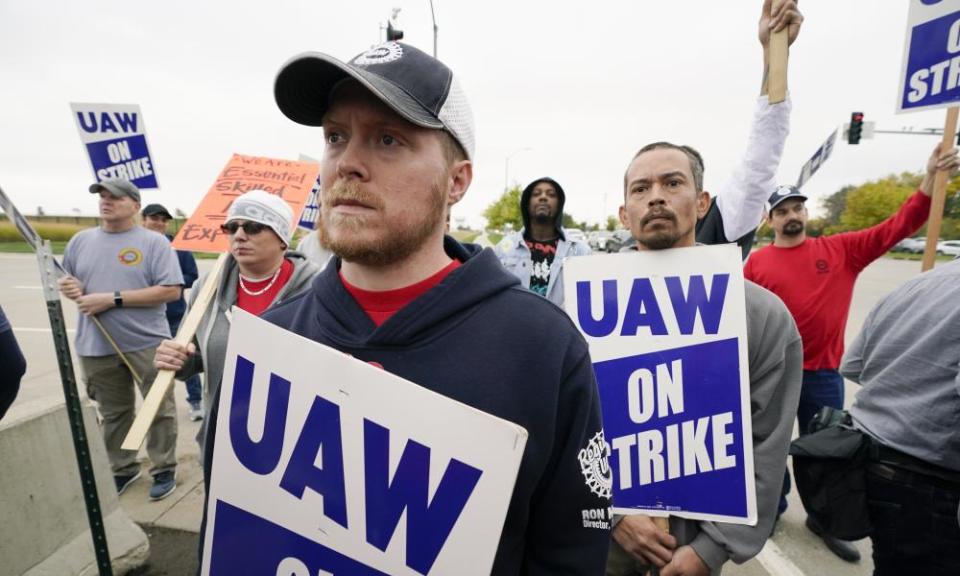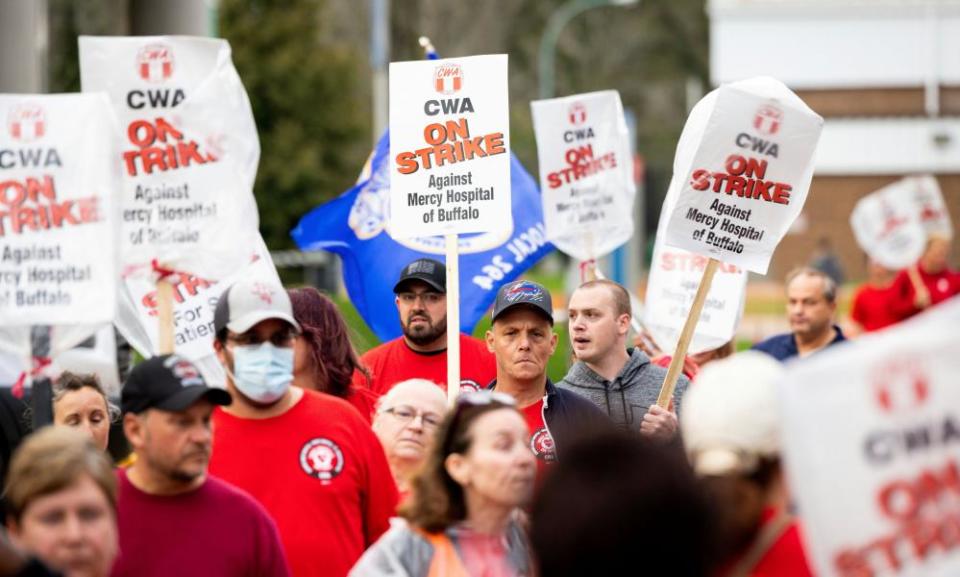‘Striketober’ is showing workers’ rising power – but will it lead to lasting change?

US labor unions have been on the defensive for decades but this October there has been a surprising burst of worker militancy and strikes as workers have gone on the offensive to demand more. Experts are predicting more actions to come but whether “Striketober” can lead to permanent change remains an open question.
The scale of industrial action is truly remarkable. Ten thousand John Deere workers have gone on strike, 1,400 Kellogg workers have walked out, as well as a walkout threatened by more than 30,000 Kaiser Permanente workers, all inflamed by a profound disconnect between labor and management.
Related: America’s strike wave is a rare – and beautiful – sight to behold | Hamilton Nolan
Many frontline workers – after working so hard and risking their lives during the pandemic – say they deserve substantial raises along with lots of gratitude. With this in mind and with myriad employers complaining of a labor shortage, many workers believe it’s an opportune time to demand more and go on strike. It doesn’t hurt that there’s a strongly pro-union president in the White House and there’s more public support for unions than in decades.
But some corporations are acting as if nothing has changed and they can continue corporate America’s decades-long practice of squeezing workers and demanding concessions, even after corporate profits have soared.
This attitude doesn’t sit well with Chris Laursen, who earns $20.82 an hour after 19 years at Deere’s farm equipment factory in Ottumwa, Iowa. Laursen is upset that Deere is offering just a one-dollar-an-hour raise and wants to eliminate pensions for future hires even when Deere anticipates a record $5.7bn in profits this year, more than double last year’s earnings.
“We were deemed essential workers right out of the gate,” Laursen said, noting that many workers racked up lots of overtime during the pandemic. “But then they came with an offer that was appallingly low. It was a slap in the face of the workers who created all the wealth for them.”
Many Deere workers complain that the company offered only a 12% raise over six years, which they say won’t keep pace with inflation, even as the CEO’s pay rose 160% last year to $16m and dividends were raised 17%. Deere’s workers voted down the company’s offer by 90% before they went on strike at 14 factories on 14 October, their first walkout in 35 years.
“We really showed up during the pandemic and kept building equipment for them,” Laursen said. “Now we want something back. The stars are finally lined up for us, and we had to bring the fight.”
Thomas Kochan, an MIT professor of industrial relations, agreed that it was a favorable time for workers – many corporations have substantially increased pay in response to the labor shortage. “It’s clear that workers are much more empowered,” he said. “They’re empowered because of the labor shortage.”
Kochan added: “These strikes could easily trigger more strike activity if several are successful or perceived to be successful.”
Robert Bruno, a labor relations professor at the University of Illinois, said workers have built up a lot of grievances and anger during the pandemic, after years of seeing scant improvement in pay and benefits. Bruno pointed to a big reason for the growing worker frustration: “You can definitely see that American capitalism has reigned supreme over workers, and as a result, the incentive for companies is to continue to do what’s been working for them. It’s likely that an arrogance sets in where companies think that’s going to last for ever, and maybe they don’t read the times properly.”

Kevin Bradshaw, a striker at Kellogg’s factory in Memphis, said the cereal maker was being arrogant and unappreciative. During the pandemic, he said, Kellogg employees often worked 30 days in a row, often in 12-hour or 16-hour shifts.
In light of this hard work, he derided Kellogg’s contract offer, which calls for a far lower scale for new hires. “Kellogg is offering a $13 cut in top pay for new workers,” Bradshaw said. “They want a permanent two-tier. New employees will no longer receive the same amount of money and benefits we do.” That, he said, is bad for the next generation of workers.
Bradshaw, vice-president of the Bakery, Confectionery, Tobacco Workers and Grain Millers union local, noted that it made painful concessions to Kellogg in 2015. “We gave so many concessions, and now they’re saying they need more,” he said. “This is a real smack in the face during the pandemic. Everyone knows that they’re greedy and not needy.”
Kellogg said its compensation is among the industry’s best and its offer will help the company meet competitive challenges. Deere said it was determined to reach an agreement and continue to make its workers “the highest paid employees in the agriculture industry”.
There are many strikes beyond Deere and Kellogg. More than 400 workers at the Heaven Hill bourbon distillery in Kentucky have been on strike for six weeks, while roughly 1,000 Warrior Met coalminers in Alabama have been on strike since April. Hundreds of nurses at Mercy hospital in Buffalo went on strike on 1 October, and 450 steelworkers at Special Metals in Huntington, West Virginia, also walked out that day. More than 30,000 nurses and other healthcare professionals at Kaiser Permanente on the west coast have voted to authorize a strike.
Sixty thousand Hollywood production employees threatened to go on strike last Monday, unhappy that film and TV companies were not taking their concerns about overwork and exhaustion seriously. But seeing that the union was serious about staging its first-ever strike, Hollywood producers flinched, agreed to compromises, and the two sides reached a settlement.
Noting that Kaiser Permanente, a non-profit, had amassed $45bn in reserves, Belinda Redding, a Kaiser nurse in Woodland Hills, California, said, “We’ve been going all out during the pandemic. We’ve been working extra shifts. Our lives have been turned upside down. The signs were up all over saying, ‘Heroes Work Here’. And the pandemic isn’t even over for us, and then for them to offer us a 1% raise, it’s almost a slap in the face.”
Redding is also fuming that management has proposed hiring new nurses at 26% less pay than current ones earn – which she said would ensure a shortage of nurses. “It’s hard to imagine a nurse giving her all when she’s paid far less than other nurses,” Redding said.
Kaiser said that its employees earn 26% more than average market wages and that its services would become unaffordable unless it restrains labor costs.

Many non-union workers – frequently dismayed with low pay, volatile schedules and poor treatment – have quit their jobs or refused to return to their old ones after being laid off during the pandemic. In August, 4.2 million workers quit their jobs, part of what has been called the Great Resignation. Some economists have suggested this is a quiet general strike with workers demanding better pay and conditions. “People are using exit from their jobs as a source of power,” Kochan said.
As for unionized workers, some labor experts see parallels between today’s burst of strikes and the much larger wave of strikes after the first and second world wars. As with the pandemic, those catastrophic wars caused many Americans to reassess their lives and jobs and ask: after what we’ve been through, don’t we deserve better pay and conditions?
Professor Bruno said that in light of today’s increased worker militancy, unionized employers would have to rethink their approach to bargaining “and take the rank and file pretty seriously”. They can no longer expect workers to roll over or to strong-arm them into swallowing concessions, often by threatening to move operations overseas.
Bruno questioned whether the surge in strikes will be long-lasting. He predicts that the improvements in pay and job quality will be long-lasting, adding that that was more likely than unions substantially increasing their membership. He said that if workers see others winning better wages and conditions through strikes, that will raise unions’ visibility and lead to more workers voting to join unions.
Despite the recent turbulence, Ruth Milkman, a sociologist of labor at City University of New York, foresees a return to the status quo. “I think things will go back to where they were once things settle down,” she said. “The labor shortage is not necessarily going to last.” She sees the number of strikes declining once the labor shortage ends.
In her view, union membership isn’t likely to increase markedly because “they’re not doing that much organizing.
“There’s a little” – like the unionization efforts at Starbucks in Buffalo and at Amazon – “but it’s not as if there’s some big push.”
A big question, Milkman said, was how can today’s labor momentum be sustained? She said it would help if Congress passed the Protecting the Right to Organize Act, which would make it easier to unionize workers. That law would spur unions to do more organizing and increase their chances of winning union drives.
“That would be a real shot in the arm,” Milkman said.

 Yahoo Finance
Yahoo Finance 